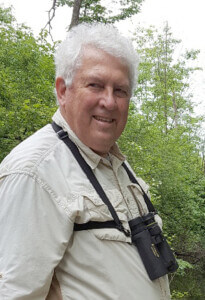RANGER STEVE’S NATURE NICHE
Mid and Late Summer Flowers
By Ranger Steve Mueller
 The progression of flower blooms advances faster than I can keep record or even identify. Grasses and sedges bloom with cryptic flowers. Many are fairly easy to identify but it takes practice. I should have taken a grass and sedge course to become more proficient. Biodiversity is massive and more than any one person can master.
The progression of flower blooms advances faster than I can keep record or even identify. Grasses and sedges bloom with cryptic flowers. Many are fairly easy to identify but it takes practice. I should have taken a grass and sedge course to become more proficient. Biodiversity is massive and more than any one person can master.
Last year I presented research results on the Moths and Butterflies of the Bryce Canyon Ecosystem – Utah at the U of California Davis campus for scientists from around the world. I identified myself as “competently incompetent”. Scientists focus their life’s work on a narrow group of species to become competent with details of anatomy, physiology, DNA/RNA, and ecology of a particular group.
College professors encouraged me to focus study on a small group if I hoped to make significant scientific contributions and become employable. Instead I focused on broad spectrum biodiversity. It was beneficial for my selected career as a nature center naturalist. I was able to assist visitors with discovery of species and ecological niches for most groups. I did not become highly proficient with any one group, including plants.
As Spring burst upon us, many showy flowers captured our attention and enthusiasm. We became anxious to spend time outdoors in refreshingly warm weather. Some of us collect Spring morels, others seeks edible leaves, flowers, and fruits, while many focus enjoyment on the pageant of beauty. Early Summer flowers replaced spring’s large flowers with smaller showy beauties followed by late Summer abundant blooms.
We become engrossed in yard upkeep, summer family activities, and plants living in our yards . We could become enthralled with the insects that visit flowers for nectar. Any one plant has a cadre of insects that visit. Predatory insects and spiders take residence among flowers where they wait for a meal to come to them. Some insects and predator lives are focused in vegetative growth. You are invited to explore Ody Brook.
Ecological niche adaptations require a narrow focus of activities for survival and reproduction. Set a portable stool by summer flowers to see what insects utilize particular plants. Some have strict use behaviors for a species or plant family while others will visit a variety of blooms. By observing areas with several blooming wild native plants, one will note different insect associations. Adult insects are often generalists when seeking nectar but are specific when selecting host plants for egg laying and young development.
Some flower shapes limit access to particular insects and that enhances pollination success. When insects visit many species of plants, they spread the incorrect pollen to the pistil and ovary. Plants with structures that require a specific insect increases reproductive success. Massive flowering increases success.
Flower timing is seasonal and so are attending insect species. Relax near early, mid, and late summer flowers to see what insects visit. You will notice some insects are present during all flowering periods and some are restricted to particular seasonal blooms.
Some flowers attract a broad variety of pollinators. Many ornamental garden flowers have been bred for beautiful appearance but have lost the ability to serve insect pollinators. Use of native plants helps preserve local biodiversity. An advantage for using native plants in gardens is it will save money. They have adaptations to local climate and require less watering, fertilizer, and pesticides. Chemicals reduce biodiversity.
Late summer blooms replace mid-summer blooms and different beautiful insects grace our yards. You might not recognize insects by name but that is not important. Enjoy their variety along with the variety of flowers. If you are like me, many flowers evade identification but that does not stop us enjoying them.
I have been seeing about 15 species of butterflies daily as mid and late summer flowers bloom at Ody Brook. Enhancing biodiversity for native plants enhances insect, bird, mammal and other organism survival.
Natural history questions or topic suggestions can be directed to Ranger Steve (Mueller) at [email protected]– Ody Brook Nature Sanctuary, 13010 Northland Dr. Cedar Springs, MI 49319of or call 616-696-1753.
